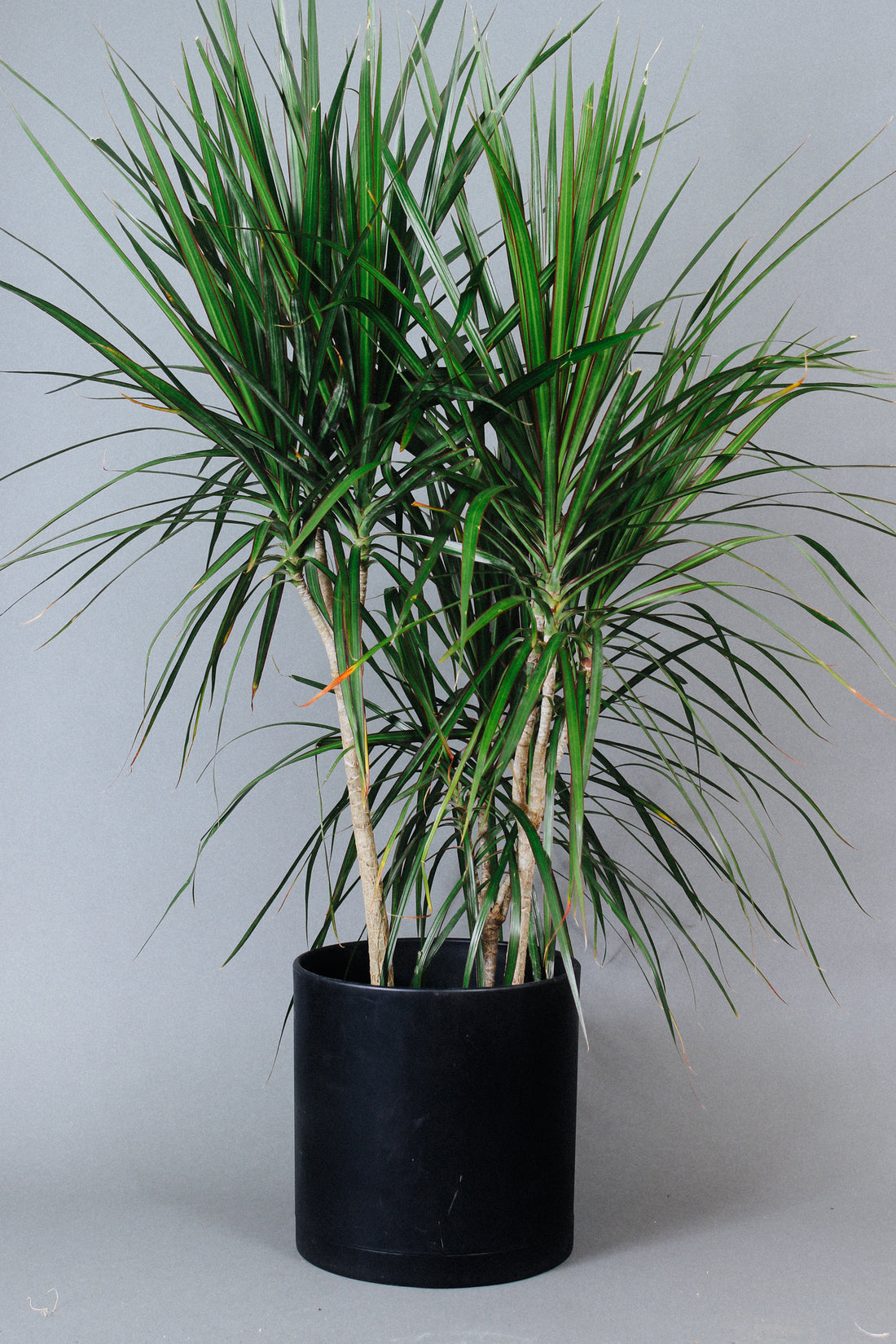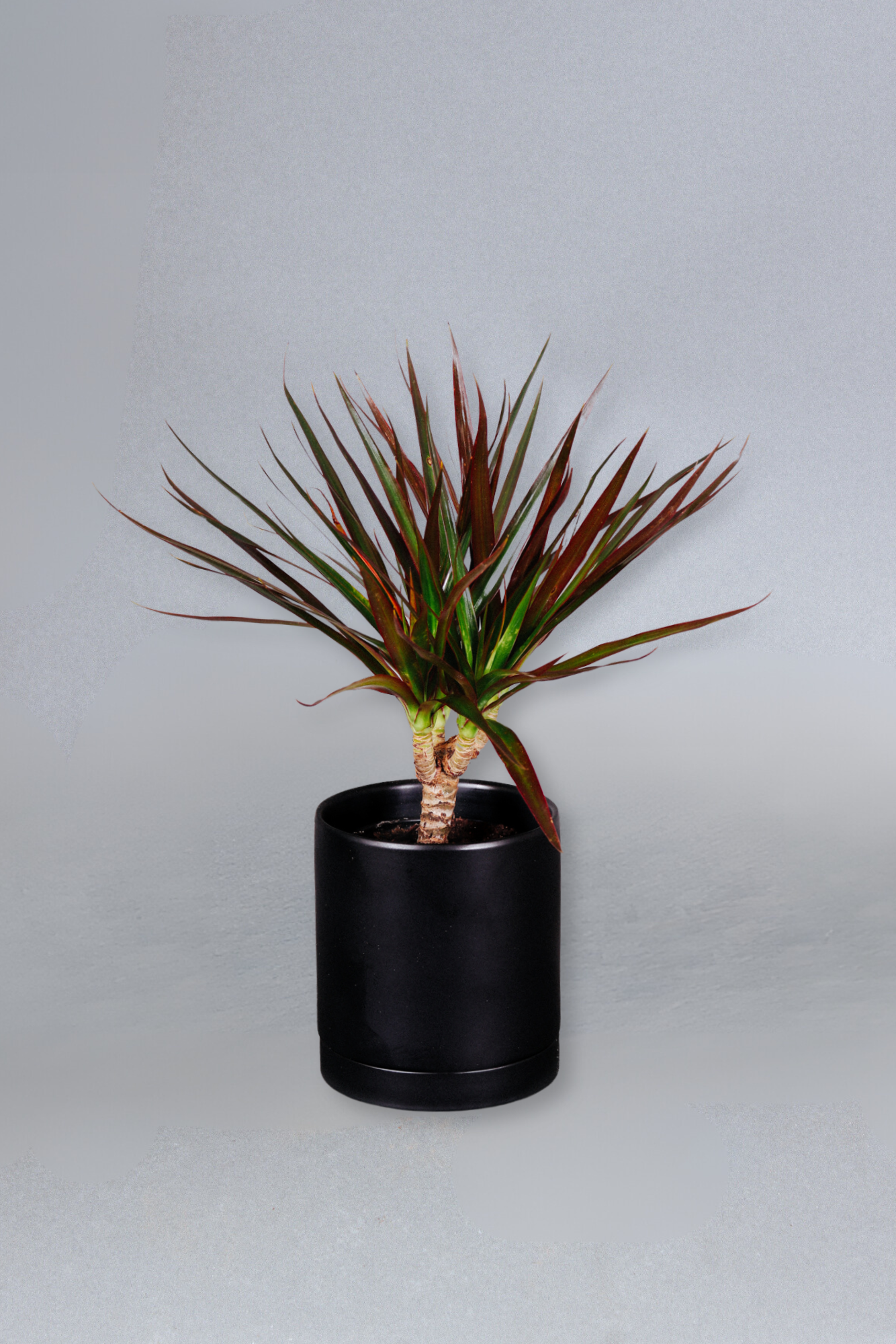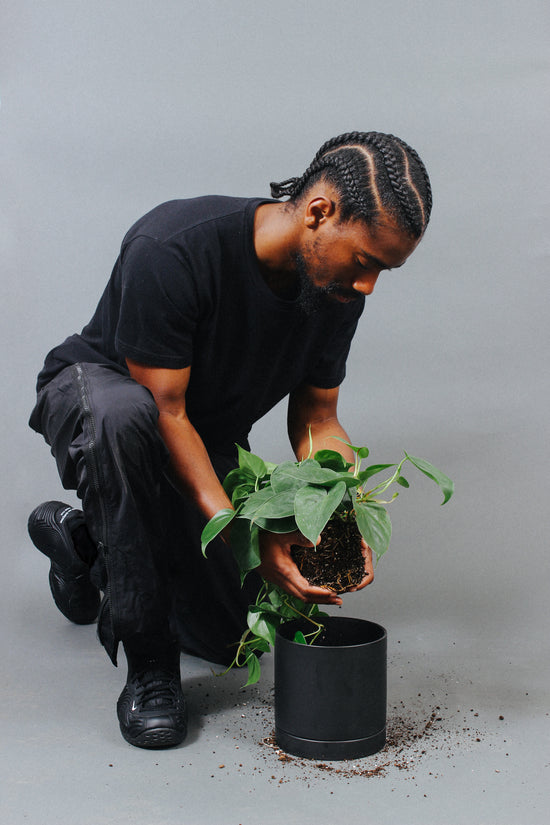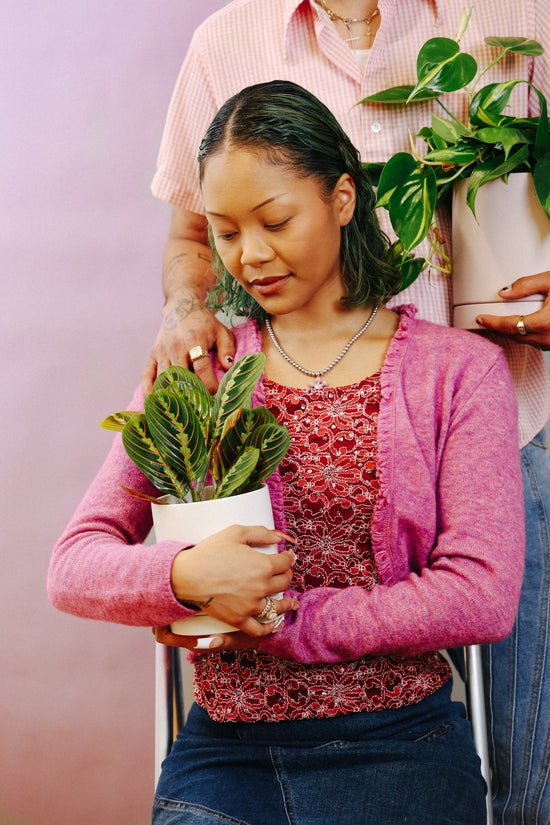The Dracaena Marginata is low fuss and beautiful, growing into a tall plant with leaves pointing to the sky. We've got all the tips and tricks to keep yours thriving.
Maintenance: Low | Climate: Warm + Humid | Light: Bright + Indirect | Watering: Semi-frequent | Pet Safe: No
CHARACTERISTICS
Originating from the subtropical lands of Madagascar, the Dracaena Marginata (also called a Dragon Tree), grows long, narrow leaves on tall, woody stems. With age, the stem will grow upright branches, expanding the plant's height and width. In its natural climate, the Marginata can tower over 20 feet. Indoors, you'll seem them grow to about 6 feet tall.
LIGHT
It prefers medium to bright, indirect light. When provided bright light, growth will be more abundant and noticeable. Sunny windows should be filtered through blinds or curtains. Rotate it often for even, healthy growth.
WATER
Water generously once the top 50%-75% of soil has dried, allowing excess water to drain out. It can tolerate a brief period of drought in between waterings since it does not enjoy wet soil. Reduce the watering frequency during fall and winter, leaning closer to 75-100% soil dryness before you repeat the routine.
AIR
The Dracaena Marginata is native to subtropical regions of South Africa. While it is typically tolerant of indoor air, we recommend providing it with extra humidity and warm temperatures above 65º.
You can boost humidity around your plant by:
- Misting the leaves 3-5x per week with non-tap water
- Adding a humidifier nearby
- Making a pebble tray that lives underneath the pot
- Placement in a bathroom or kitchen, if lighting is suitable
PLACEMENT
Dracaena Marginatas carry the symbol of good fortune and happiness. Place them in any spot that may bring warmth and positivity to those who enter your space. In addition to ensuring its environmental needs are met, these look great where they can spread out and grow into their full potential. According to ancient Feng Shui practices, intentionally placing a plant like the Dracaena at the center of your home attracts this joyful energy towards health and overall wellbeing.
POTTING & SOIL
We recommend a ceramic planter with plenty of drainage to provide an ideal moisture balance for your Marginata. When repotting, keep it in a planter of the same size or no more than 2 inches larger. It can be repotted every 1-2 years in the beginning, then only every few years once it’s mature. We recommend a well-draining soil with amendments such as bark, perlite, and sand will provide a healthy balance of moisture retention, aeration, and drainage.
SEASONAL CARE
Like other plants, Marginatas have different needs during fall and winter when they are resting to prepare for the growing season. Keep some of these pointers in mind:
- Maintain comfortable temperatures and moderate humidity levels through fall and winter
- Keep it away from vents, heat sources, and cold windows
- If possible, bring it to a brighter area to make up for shorter daylight during winter
- During cold months, water less frequently (only once the soil has dried 75%)
- Avoid repotting, fertilizing, and other drastic changes that stress the plant
PRUNING & PROPAGATION
You'll find many opportunities to keep your Dracaena pruned and in tip-top appearance. They commonly shed the lowest, oldest leaves as they grow taller. Remove yellow, brown, and damaged leaves as they come. You can cut away brown tips carefully by avoiding the healthy green flesh.
How to prune a Dracaena Marginata to promote growth:
- Cut a healthy stem at a 45º angle using clean shears or scissors. A sharp, sturdy tool is recommended to prevent damage to the thick stem.
- Sprinkle cinnamon on the exposed cut to prevent infection
- Over time, new branches will sprout from the cut, producing a fuller appearance.
How to Propagate a Dracaena Marginata:
- Select a healthy stem at least 4 inches long with multiple healthy leaves.
- Make a 45º cut on the stem
- Allow the stem cutting to sit out for a few hours and callous over
- Place the cutting in a clean glass of non-tap water or a moist soilless mixture of coco coir, sand, and perlite.
- With regular attention, roots will begin to grow in a few weeks.
- Pot into soil once roots are 3+ inches.
Be aware that the longer your propagations sit in water, the harder it will be for them to transition to soil when they're potted. Never prune plants more than 10-20% at a time.
COMMON ISSUES
While Dracaena Marginatas easily become one a low-maintenance plant in your collection, you may notice some of these common issues:
YELLOW LEAVES
Yellow Leaves on your Dracaena are most often from overwatering or an environmental change (such as temperature or a big move). Old leaves near the bottom will also go yellow with age before eventually falling off. If the soil is wet, reduce your watering frequency and ensure the soil and planter have good drainage.
BROWN LEAVES, TIPS, OR EDGES
Brown tips on the Dracaena are usually the first sign of underwatering. This can also be a result of excessively dry air or scorch from direct sunlight. Start by assessing the soil moisture and how often you’re watering. Make sure you are offering medium or bright, indirect light and some extra humidity.
LOSING LEAVES
Leaf loss on a Dracaena isn’t always worrisome but if you’re seeing it in drastic amounts, you’ll want to troubleshoot quickly. Drafty, cold areas, fluctuating temperatures, and big changes can stress a Dracaena to the point of leaf loss. Additionally, overwatering and underwatering are common causes for shedding leaves.
DROOPING, LIMP LEAVES
Drooping leaves are the Dracaenas' first sign of thirst and stress. They can easily perk back up when provided with proper care and some time to rest. If they don’t perk back up after a few days, go through the rest of these Common Issues to see what the cause may be.
SHRIVELED TRUNK
When a Dracaena is overwatered or receiving improper drainage, the roots begin to rot from lack of oxygen. Eventually, the stem will shrivel, a sad sign that your plant is in trouble. You’ll need to assess how bad the damage is by removing the plant from the pot to examine the roots. Dark, mushy roots are a sure sign of root rot. If the plant has any healthy roots left, repot it and slowly nurse it to health, being cautious to water after the soil is 75% dry.
PRO TIPS
- Dracaenas are not too fussy so long as you give them a stable environment and don’t overwater them!
- Encourage fuller growth by pruning away a portion of healthy them. Soon enough new branches will sprout out.
Any questions on caring for your Dracaena? Send ‘em our way!








